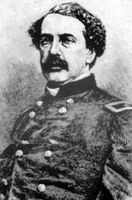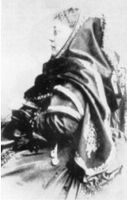Blavatsky H.P. - Madame Blavatsky Protests: Difference between revisions
(Created page with "{{HPB-CW-header | item title = Madame Blavatsky Protests | item author = Blavatsky H.P. | volume = 1 | pages = 238-241 | publications = The World, New Yor...") |
(No difference)
|
Revision as of 14:40, 3 September 2023
238
MADAME BLAVATSKY PROTESTS
To the Editor of The World:
Sir,—There was a time when the geocentric theory was universally accepted by Christian nations, and if you and I had been carrying on our little philological and psychological controversy, I should have bowed in humility to the dictum of an authority so “particularly at home” in “the mysticism of the Orient.” But despite all modifications of our astronomical system, I am no heliolater, though I do 239 subscribe for the Sun as well as The World. I feel no more bound to “cajole” or “conciliate” the one than to suffer my feeble taper to be extinguished by the draught made by the other in its diurnal rush through journalistic space.
As near as I can judge from your writing there is this difference between us, that I write from personal experience and you upon information and belief. My authorities are my eyes and ears, yours obsolete works of reference and the pernicious advice of a spontaneously-generated “lampsakano,” who learned his mysticism from the detached head of one Dummkopf. (See the Sun of March 25th.) My assertions may be corroborated by any traveller, as they have been by the first authorities. Elphinstone’s Kingdom of Kabul, etc., was published sixty-two years ago (1815) ; [1] his The History of India thirty-six years ago. If the latter is the “standard text book” for British civil servants it certainly is not for native Hindoos, who perhaps know as much of their philosophy and religion as he. In fact, a pretty wide reading of European “authorities” has given me a very poor opinion of them, since no two agree. Sir William Jones, whose shoestrings few Orientalists are worthy to untie, made, himself, very grave mistakes, which are now being corrected by Max Müller and others. He knew nothing of the Vedas (see Max Müller’s Chips, Vol. I, p. 183), and even expressed his belief that Buddha was the same as the Teutonic deity Wodan or Odin, and Sâkya—another name of Buddha—the same as Shishac, a king of Egypt! Why, therefore, could not Elphinstone make a mess of such subtle religious distinctions as the innumerable sects of Hindoo mystics present?
I am charged with such ignorance that I imagine the fakirs to be “holy mendicants of the religion of Brahmâ,” while you “say they are not of the religion of Brahmâ at all, but Mahometans.” Does this precious piece of information come also from Elphinstone? Then I give you a Roland 240 for your Oliver. I refer you to James Mill’s The History of British India (Vol. I, p. 283; London, 1858). You say “those seeking ready-made information can find our statements corroborated in any encyclopaedia.” Perhaps you refer to Appleton’s? Very well. In the article on James Mill (Vol. II, p. 501) [2] you will find it saying that his India was the first complete work on the subject. “It was without a rival as a source of information, and the justice of its views appeared in the subsequent measures for the government of that country.” Now, Mill says that the fakirs are a sect of Brahmanism; and that their penances are prescribed by the Laws of Manu. Will your Lamp-sickener, or whatever the English of that Greek may be, say that Manu was a Mahometan? And yet that would be no worse than your clothing the fakirs—who belong, as a rule, to the Brahman pagodas—in yellow, the color exclusively worn by Buddhist lamas, [3] and breeches which form part of the costume of the Mahometan dervishes. Perhaps it is a natural mistake for you Lampsakanoi, who rely upon Elphinstone for your facts and have not visited India, to confound the Persian dervishes with the Hindoo fakirs. But “while the lamp holds out to burn,” read Louis Jacolliot’s Bible in India, just out, and learn from a man who has passed twenty years in India that your correspondent is neither a fool nor a liar.
You charge me with saying that a fakir is a “worshipper of God.” I say I did not, as the expression I used, “fakir is a loose word,” well proves. It was a natural mistake of the


240
reporter, who did not employ stenography at our interview. I said, “A Svâmi is one who devotes himself entirely to the service of God.” All Svâmis of the Nir-Narrain sect are fakirs, but all fakirs are not necessarily Svâmis. I refer you to Coleman’s The Mythology of the Hindus (p. 244), and to the Asiatic Journal. Coleman says precisely what Louis Jacolliot says, and both corroborate me. You very obligingly give me a lesson in Hindustani and the Devanagari, and teach me the etymology of “guru,” “Fakir,” “Gosain,” etc. For answer I refer you to John Shakespear’s large Hindustani-English Dictionary. I may know less English than you Lampsakanoi, but I do know of Sanskrit and Hindustani more than can be learned on Park Row.
As I have said in another communication, I did not invite the visits of reporters, nor seek the notoriety which has suddenly been thrust upon me. If I reply to your criticisms—rhetorically brilliant, but wholly unwarranted by the facts—it is because I value your good opinion (without caring to cajole you), and at the same time cannot sit quiet and be made to appear alike devoid of experience, knowledge and truthfulness.
Respectfully, but still rebelliously, yours,
H. P. BLAVATSKY. Monday, April 2nd, 1877.
Footnotes
- ↑ [The original title of this work by Mounstuart Elphinstone was: An Account of the Kingdom of Caubul, and its Dependencies in Persia, Tartary, and India, etc., London, 1815.—Compiler.]
- ↑ [Reference is probably to the Appleton’s Cyclopaedia of Biography. It is not known what edition H.P.B. had in mind. In the 1872 edition although the above wording does not occur, the ideas expressed about Mill’s work are equally laudable.—Compiler.]
- ↑ [This must be a lapsus calami on the part of H.P.B. Yellow is worn by Buddhist monks of the Southern School but not by Tibetan Lamas. The Bhikkus of the Theravâda School have, since the foundation of the Order by the Buddha, worn three robes of various shades of orange or yellow. Members of the Gelug-pa Order of Tibetan Buddhism, founded in the fourteenth century by Tsong-kha-pa, wear on special occasions yellow hats as distinct from the red hats worn by other sects, and on certain festive occasions yellow silk over their maroon robes.—Compiler.]
